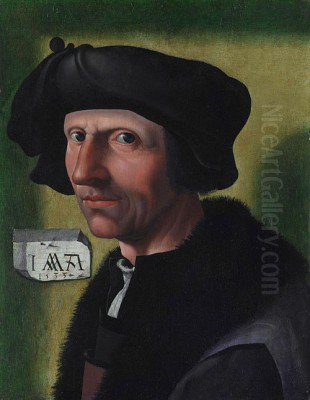
Jacob Cornelisz van Oostsanen stands as a significant, if sometimes underappreciated, master in the rich tapestry of Netherlandish art. Active during a transformative period that witnessed the waning of the Late Gothic style and the burgeoning influence of the Renaissance, Van Oostsanen was a prolific painter and a pioneering woodcut artist. His career, primarily based in Amsterdam, marks him as one of the first major artists to establish a prominent workshop in that city, laying foundational stones for its future as a vibrant artistic center. His life and work offer a fascinating glimpse into the artistic, religious, and cultural currents of the Northern Netherlands in the late fifteenth and early sixteenth centuries.
Early Life and Formative Influences
The precise birth year of Jacob Cornelisz van Oostsanen remains a subject of scholarly discussion, though the consensus leans towards a date around 1475. Some earlier accounts proposed dates as early as 1465 or 1470, but these lack definitive documentary support. He was born in the village of Oostsanen, now Oostzaan, in North Holland, from which he derived his cognomen "van Oostsanen" (from Oostsanen). This practice of adopting a toponymic surname was common for artists and craftsmen of the era, immediately identifying their place of origin.
Details about his early training are scarce, a common challenge when studying artists of this period. However, art historians surmise that he likely received his initial artistic education in Haarlem, a prominent artistic center in North Holland at the time. The stylistic qualities of his early work exhibit affinities with the Haarlem school, particularly with the artistic traditions associated with painters like Geertgen tot Sint Jans, who was active in Haarlem in the late fifteenth century. Geertgen's delicate figures, expressive faces, and attention to landscape details may have left an impression on the young Jacob Cornelisz. The influence of earlier Netherlandish masters, such as Jan van Eyck and Rogier van der Weyden, though from a previous generation, would have still permeated the artistic environment through their enduring masterpieces and the continuation of their stylistic legacies by subsequent artists.
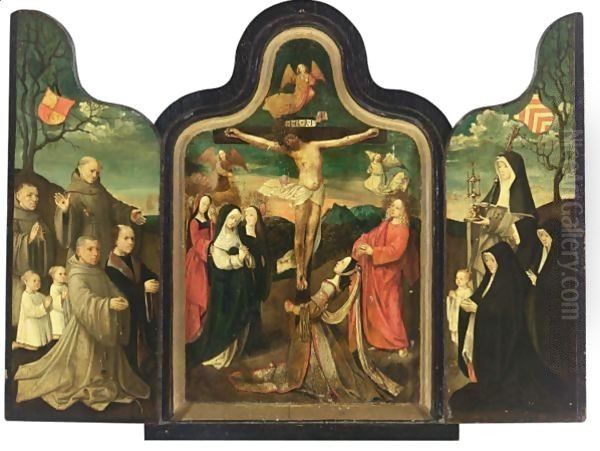
It is also plausible that Van Oostsanen spent some time as a journeyman, traveling and working in different workshops to broaden his skills and experience, a common practice for aspiring artists. This period would have exposed him to various regional styles and techniques, contributing to the development of his own artistic voice.
Establishment in Amsterdam and the Workshop
Around the year 1500, Jacob Cornelisz van Oostsanen made a pivotal move, settling in the rapidly growing city of Amsterdam. This decision was significant, as Amsterdam was on the cusp of becoming a major commercial and cultural hub. In the same year, records indicate he purchased his first property on the Kalverstraat, a prominent street that would become central to his life and career. It was here that he established a highly successful and productive workshop.
Van Oostsanen's workshop was not merely a place for painting; it was a multifaceted artistic enterprise. It produced a wide array of works, including panel paintings (altarpieces, devotional images, and portraits), designs for stained glass windows, patterns for ecclesiastical vestments and other textiles, and, notably, a vast number of woodcuts. This diversity of output demonstrates his versatility as a designer and his entrepreneurial acumen in catering to the varied demands of patrons, who included ecclesiastical institutions, civic bodies, and private individuals.
The workshop appears to have been, to some extent, a family affair. His brother, Cornelis Buys I, also known as the Master of Alkmaar, was a painter, suggesting an established artistic lineage or shared familial inclination towards the arts. Later, Jacob's own son, Dirck Jacobsz., would become a renowned painter in his own right, particularly noted for his portraits, continuing the family's artistic legacy in Amsterdam. His grandson, Cornelis Anthonisz., also pursued an artistic career, further cementing the family's contribution to Netherlandish art. This familial involvement was common, allowing skills to be passed down and often enabling family members to work collaboratively without the stringent guild restrictions that might apply to unrelated apprentices.
Artistic Development and Stylistic Evolution
Jacob Cornelisz van Oostsanen's artistic career spanned several decades, during which his style underwent a discernible evolution, reflecting the broader artistic shifts occurring in Northern Europe. His work forms a bridge between the deeply rooted traditions of Late Gothic art and the innovative spirit of the Renaissance.
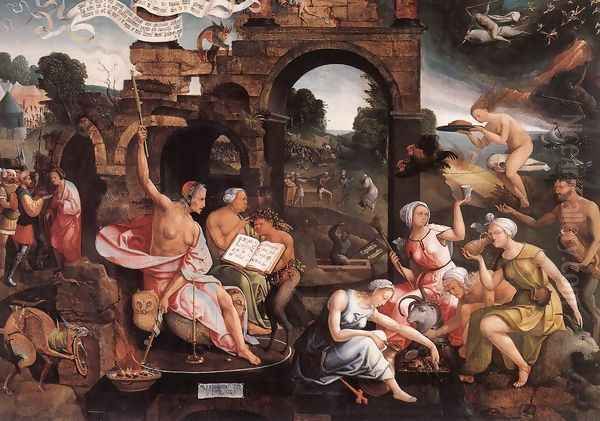
His early works, dating from roughly 1500 to 1510, are characterized by a style that is firmly grounded in the Netherlandish Late Gothic tradition. These paintings often feature elongated figures, intricate drapery with angular folds, and a meticulous attention to detail. Compositions can be crowded, filled with narrative elements and rich symbolism. The color palettes tend to be strong and somewhat somber, typical of the period. Works like his early religious scenes demonstrate a continuity with the artistic language of his predecessors.
During his middle period, from approximately 1510 to 1520, Van Oostsanen began to incorporate emerging Renaissance motifs, particularly in decorative elements and architectural frameworks. While the core figural style often retained its Gothic sensibility, there was an increasing awareness of classical forms and a move towards more balanced and harmonious compositions. The influence of German artists, particularly the powerful and pervasive impact of Albrecht Dürer through his widely circulated prints, can be discerned. Dürer's mastery of perspective, human anatomy, and his innovative approach to composition resonated throughout Europe, and Van Oostsanen was likely among the many Netherlandish artists who studied his work.
The late phase of his career, from the 1520s until his death in 1533, shows a more pronounced engagement with Renaissance ideals. His figures often become more substantial and rounded, their poses more naturalistic. There is a greater sense of spatial depth and a softer, more nuanced use of color and light. This shift may reflect the growing influence of artists who had traveled to Italy or had more direct exposure to Italian Renaissance art, such as Jan Gossaert (also known as Mabuse) and Jan van Scorel. These artists were instrumental in introducing Italianate forms and themes to the Northern Netherlands. Van Oostsanen's later works, while still often deeply religious in subject matter, exhibit a greater elegance and a more humanistic sensibility.
Major Themes and Subjects
The vast majority of Jacob Cornelisz van Oostsanen's painted oeuvre consists of religious subjects, a reflection of the primary role of the Church as a patron of the arts during this period. He produced numerous altarpieces for churches and chapels, as well as smaller devotional panels for private contemplation. Popular themes included scenes from the Life of Christ, such as the Nativity, the Crucifixion, and the Resurrection, as well as depictions of the Virgin Mary, saints, and biblical narratives.
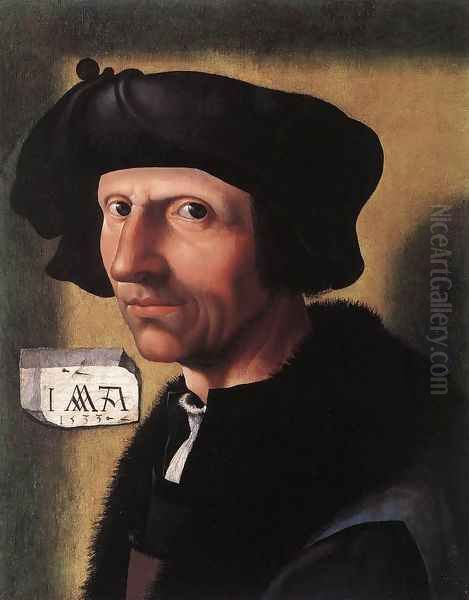
His triptychs, such as the Last Judgment and works depicting the Sorrows of the Virgin, were significant commissions that would have adorned important ecclesiastical spaces. These multi-panel formats allowed for complex iconographical programs, often incorporating donor portraits and intricate symbolic details that would have been readily understood by contemporary viewers. For example, his Triptych with the Last Supper (c. 1525-1530) demonstrates his ability to manage complex group compositions and convey dramatic religious narratives.
While religious art formed the core of his output, Van Oostsanen also produced portraits. His Self-Portrait of 1533, painted in the year of his death, is a particularly compelling work. It shows the artist at an advanced age, holding a coat of arms, a statement of his status and professional pride. Unusually, the painting also includes a depiction of his mother in the background, creating a poignant, multi-generational image. This work is one of the earliest dated self-portraits by a Dutch artist. His portraiture, while perhaps not as central to his fame as his religious works or woodcuts, contributed to the growing tradition of portrait painting in the Netherlands, a genre that his son, Dirck Jacobsz., would later specialize in.
Woodcuts: A Pioneering Contribution
Beyond his paintings, Jacob Cornelisz van Oostsanen made a highly significant contribution as a designer of woodcuts. He is considered one of the earliest and most prolific woodcut artists in the Northern Netherlands. He began producing designs for woodcuts around 1507, and his total output is estimated to be around 200 prints. These were often created for book illustration or as individual devotional images.
His woodcut series, such as The Life of the Virgin (begun 1507) and the Passion of Christ, were widely disseminated and highly influential. These prints demonstrate his skill in composition, his ability to convey narrative clarity within the demanding medium of woodcut, and his keen eye for expressive detail. The lines are often vigorous and dynamic, capturing a sense of movement and emotion. He frequently collaborated with Amsterdam publishers, such as Pieter Doenszijt, ensuring his designs reached a broad audience.
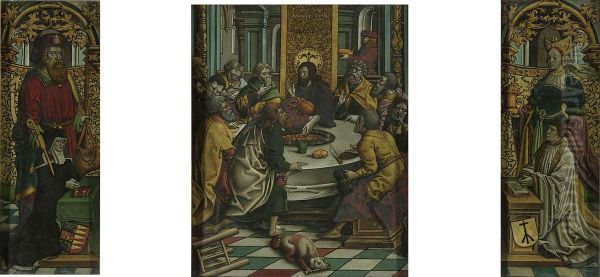
The production of woodcuts was a crucial aspect of the artistic landscape of the early sixteenth century. Prints were relatively inexpensive and could be produced in large numbers, making art accessible to a wider segment of society than unique paintings. They played a vital role in the dissemination of artistic styles, religious ideas, and iconographic motifs. Van Oostsanen's woodcuts, alongside those of contemporaries like Lucas van Leyden, who was a master engraver and painter, helped to establish the Northern Netherlands as an important center for printmaking. The influence of Albrecht Dürer is again notable here, as Dürer had revolutionized the art of woodcut, elevating it to a high art form.
Key Representative Works
Several key works exemplify Jacob Cornelisz van Oostsanen's artistic achievements and stylistic range:
The Crucifixion (c. 1507-1510): This relatively early panel, now in the Rijksmuseum, Amsterdam, showcases his mastery of traditional Netherlandish techniques. It is a densely populated scene, filled with expressive figures and rich in narrative detail, characteristic of the Late Gothic style. The emotional intensity of the event is palpable, conveyed through the gestures and facial expressions of the mourners and soldiers.
Saul and the Witch of Endor (1526): Also in the Rijksmuseum, this painting from his later period demonstrates his stylistic evolution. The figures are more monumental and classically inspired, the composition is more spacious, and the handling of light and shadow creates a dramatic atmosphere. The subject matter, drawn from the Old Testament, reflects the ongoing interest in biblical narratives, but the treatment shows an assimilation of Renaissance aesthetics.
Nativity (c. 1512): This work, now in the Museo di Capodimonte, Naples, is a fine example of his ability to blend traditional iconography with a burgeoning Renaissance sensibility. The intricate details, rich colors, and tender depiction of the Holy Family are characteristic of his devotional paintings.
Salome with the Head of John the Baptist (c. 1524): Housed in the Rijksmuseum, this painting displays a more refined and elegant style. Salome's figure is rendered with a certain grace, and the composition is balanced, reflecting the increasing influence of Renaissance ideals of beauty and harmony, even when depicting a gruesome subject.
Self-Portrait (1533): As mentioned earlier, this late work is significant not only as a personal document but also for its artistic qualities. It reveals the artist's confidence and his place within Amsterdam society.
These works, among many others, illustrate Van Oostsanen's skill in handling diverse subjects, his evolving style, and his importance in the artistic milieu of his time.
Influences, Contemporaries, and Collaborations
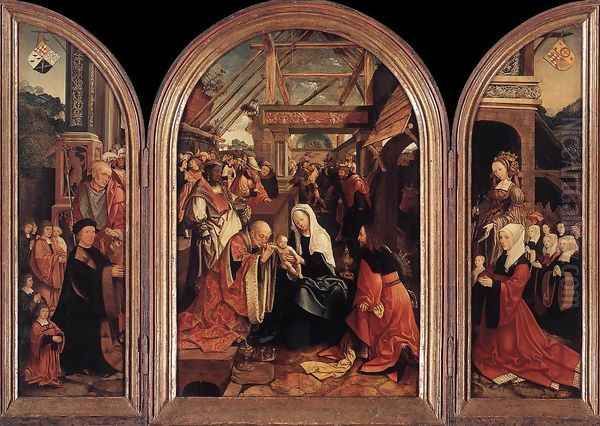
Jacob Cornelisz van Oostsanen did not work in isolation. He was part of a dynamic artistic network, influenced by predecessors and contemporaries, and in turn, influencing others. As discussed, the legacy of earlier Netherlandish masters like Geertgen tot Sint Jans provided a foundation. The transformative impact of Albrecht Dürer's prints was undeniable, offering new models for composition, figural representation, and printmaking techniques.
Within the Netherlands, artists like Jan Gossaert and Jan van Scorel were key figures in transmitting Italian Renaissance ideas. Gossaert was one of the first Netherlandish artists to travel to Rome (1508-1509) and absorb classical art firsthand. Van Scorel also undertook an Italian sojourn, and his return to the Netherlands significantly impacted the development of Renaissance art in the North. While Van Oostsanen himself is not documented as having traveled to Italy, the influence of these "Romanists" would have been felt through their works and the general artistic discourse.
Other notable contemporaries in the Low Countries included Quentin Matsys in Antwerp, who was a leading figure in the transition from Gothic to Renaissance styles in the Southern Netherlands. In Haarlem, Jan Mostaert was an important painter, known for his religious scenes and portraits. The slightly earlier, highly individualistic art of Hieronymus Bosch also cast a long shadow, though Bosch's style was unique and less directly emulated.
Van Oostsanen's collaborations extended beyond his workshop. His work with the carpenter Thomas Bartholomew on a large altarpiece for Egmond Abbey indicates his involvement in major, multi-component commissions. His relationship with publishers like Pieter Doenszijt was crucial for the dissemination of his woodcuts.
The Reformation's Context
Jacob Cornelisz van Oostsanen worked during a period of profound religious upheaval with the rise of the Protestant Reformation. While the Northern Netherlands would eventually become predominantly Protestant, during Van Oostsanen's lifetime, Catholicism was still the dominant faith, and the Church remained a primary source of artistic patronage. His extensive body of religious art catered to traditional Catholic devotion.
However, the shifting religious landscape may have subtly influenced art. Some scholars suggest that certain works, like his depictions of Christ as Man of Sorrows, could have resonated with emerging reformist sentiments that emphasized a more personal and direct relationship with Christ's suffering, potentially serving an educative or devotional purpose for various audiences, including those leaning towards new religious ideas. The full impact of the Reformation on art in Amsterdam would become more apparent in the decades following Van Oostsanen's death.
Family Legacy and Later Life
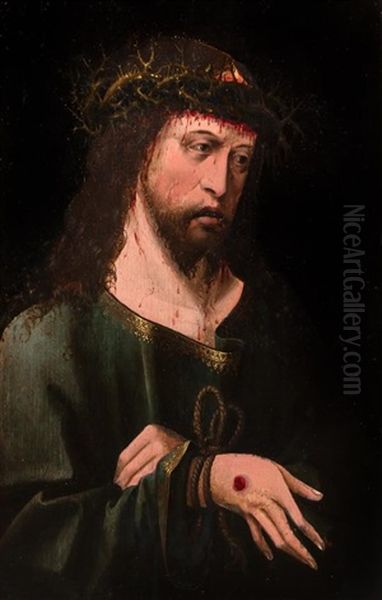
Jacob Cornelisz van Oostsanen's artistic legacy was directly continued by his son, Dirck Jacobsz. (c. 1496–1567). Dirck trained in his father's workshop and became a highly respected painter in Amsterdam, particularly renowned for his portraits, including some of the earliest group portraits of civic guards, a genre that would become a hallmark of Dutch Golden Age painting. This specialization in portraiture by Dirck Jacobsz. marks a significant development in the Amsterdam art scene. Jacob's grandson, Cornelis Anthonisz. (c. 1505–c. 1553), was also an artist, known for his paintings, woodcuts, and cartography, most famously his bird's-eye view map of Amsterdam.
Jacob Cornelisz van Oostsanen died in Amsterdam in 1533. His wife, about whom little is known, passed away in 1546. His death marked the end of a productive and influential career that had significantly shaped the artistic landscape of Amsterdam.
Conclusion: An Enduring Contribution
Jacob Cornelisz van Oostsanen was a pivotal artist in the Northern Netherlands during a period of significant artistic transition. He successfully navigated the shift from the Late Gothic style to the emerging Renaissance, incorporating new ideas while retaining a distinct Netherlandish character in his work. As the head of a thriving workshop in Amsterdam, he was a versatile artist, excelling in painting and making groundbreaking contributions to the art of woodcut.
His religious paintings adorned churches and private homes, fulfilling the devotional needs of his patrons. His portraits captured the likenesses of his contemporaries, and his woodcuts reached a wide audience, disseminating images and narratives far beyond the confines of elite patronage. He played a crucial role in establishing Amsterdam as an important artistic center, paving the way for the later efflorescence of art in the Dutch Golden Age, which would see artists like Rembrandt van Rijn and Johannes Vermeer build upon the rich artistic foundations laid by earlier masters. Though perhaps not as universally recognized today as some of his Italian contemporaries or later Dutch masters, Jacob Cornelisz van Oostsanen's contribution to the history of art is undeniable and deserving of continued appreciation and study.